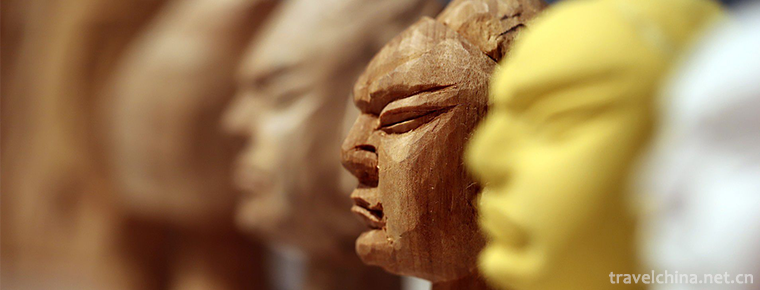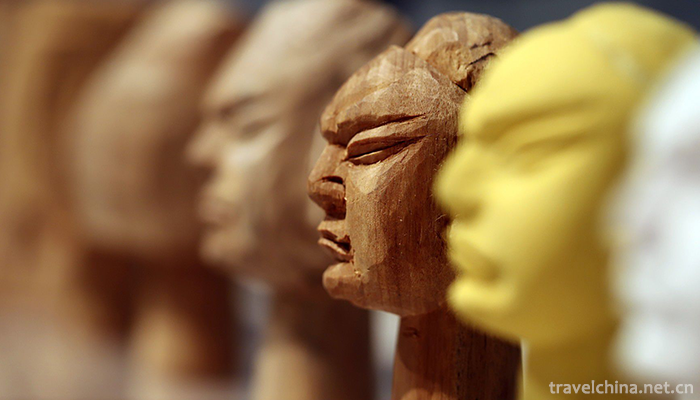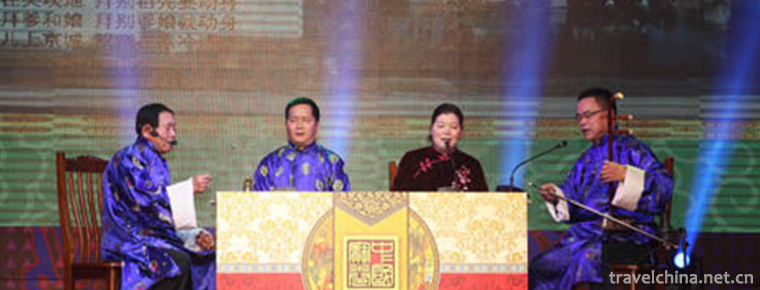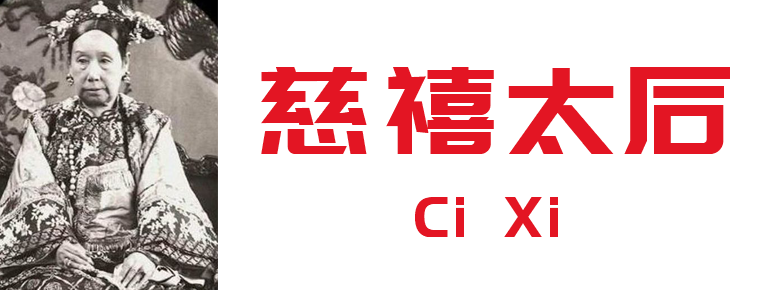2019-06-14

- By ChinaWiki.net
- Chinese Edition
- 2019-06-06
Puppet Head Sculpture
Zhangzhou puppet head carving is a traditional folk arts and crafts in Zhangzhou City, Fujian Province. It belongs to a special skill in the production of puppet stage props. Zhangzhou puppet head carving mainly distributes in Zhangzhou City, Xiamen City, Quanzhou City and surrounding areas of Fujian Province. The overall shape of Zhangzhou puppet includes head, limbs, clothing, helmet and so on. Puppet head carving only refers to head shape. As the sculpture of personage head in opera stage, it pays great attention to the characterization of personage's personality. The exaggerated shape, rich expression and typification are the common characteristics of Zhangzhou puppet head sculpture. This sculpture has always been handed down by teachers and apprentices, and is mainly handed down by family ancestors. It has been handed down uninterruptedly till now.
On May 20, 2006, Zhangzhou puppet head carving was approved by the State Council to be included in the first batch of national intangible cultural heritage list.
Historical Origin
Zhangzhou puppet carving began in Jin Dynasty and flourished in Tang Dynasty. It has a history of nearly two thousand years. Folk artists Xu Niansong and Xu Shengfang's puppet works were collected by art and craft departments after the founding of New China. In 1959, Xu Niansong's carved puppet heads of Shengdan and Dandan were selected to participate in the national arts and crafts exhibition and were well received by the cultural and art circles. Xu Zhuchu, Xu's son, inherited and innovated. From 1979 to 1989, his works were exhibited in Australia, the United States, Taiwan and Hong Kong and won a high reputation. Xu Zhuchu's representative works of puppet heads are treasured in Zhuchu Puppet Art Museum on the second floor of Garden Building, Yan'an North Road in the urban area.
Since the Ming and Qing Dynasties, puppet shows have gradually evolved from cities to towns, and formed puppet plastic arts of different styles and schools. For example, in Quanzhou Jiali Opera in Fujian Province, there are only four actors, Sheng, Dan, Bei (Jing), Za (Ugly), which are called "Four Beautiful Classes". Some Jiali operas have only 36 images, so they are called "36 Jiali as a million soldiers". Quanzhou's early famous puppet head sculptor, the idol shop and puppet craftsmen in Yiquan Backstreet, Huang Liangsi and Huang Caisi in Tumen Street, and later Huang Jiaxiang and Jiang Jiagao, the puppet sculptor in Beimen Garden Street. Their puppet sculpture, exquisite sculpture, rich face, with the characteristics of figures in the Tang Dynasty; meticulous pastel, bright lines, forming a Southern Fujian puppet model. The puppet puppet show of Zhangzhou in Longxi area was very popular in Qing Dynasty. Xu Ziqing, a puppet sculptor, was very popular in the twelve years of Jiaqing in the Qing Dynasty. Xu Ziqing, a puppet sculptor, opened Chengcheng Shi Puppet Workshop in Dongmen of Zhangzhou in the twelfth year of Jiaqing in the Qing Dynasty (1807). Xu Niansong, a puppet sculptor known as "Nanjiang (Jiagou) Beixu", is the representative of the Beijie School. By the beginning of Xu Zhuchu's generation, it has been the sixth generation.
Inheritance Significance
It has a broader social mass base.
Puppet show in southern Fujian has a relatively broad social mass base, and the plastic arts of puppet heads have also gained a deep foundation for development. The art of puppet head sculpture is closely related to traditional opera. In the situation of the general decline of opera performance, the inheritance of puppet head sculpture technology also encounters difficulties: if we stick to the stage, puppet head sculpture can only go silent with the opera; if we leave the stage, puppet head sculpture can only become a simple ornament, and many of the living culture of its traditional skills will be lost. At present, Zhangzhou puppet head carving is facing such a situation, which needs the attention of relevant parties.
Facing the danger of "extinction"
As a traditional folk art, Zhangzhou's puppet carving has always followed the ancient system of inheriting men from women. In the contemporary era, most of the descendants of old artists are reluctant to learn puppet carving, because this skill is time-consuming, laborious and economically unproductive, and many old artists have to change careers. This national treasure is facing the danger of "extinction" because nobody succeeds.
Listed in the First National List of Non-material Cultural Heritage
The state attaches great importance to the protection of intangible cultural heritage. On May 20, 2006, the intangible cultural heritage was approved by the State Council and listed in the first batch of national intangible cultural heritage list. On June 5, 2007, Xu Zhuchu and Xu Congliang in Zhangzhou City, Fujian Province, were confirmed by the Ministry of Culture as the representative successors of the cultural heritage projects, and were listed in the first batch of 226 representative successors of the national intangible cultural heritage projects.

Ask a Question
Your email address will not be published.



0 Questions